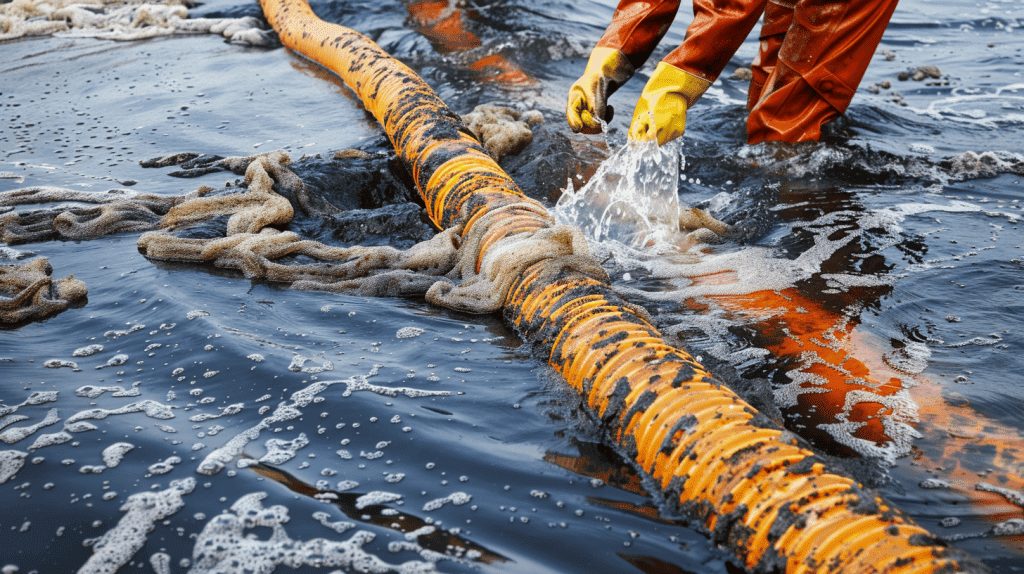Spill containment booms are essential tools for controlling and mitigating the spread of oil spills in water bodies. These barriers help contain the spill, making it easier to recover and prevent environmental damage. However, effective use of spill containment booms requires proper training and a keen understanding of safety considerations. In this article, we’ll discuss the training requirements and safety measures necessary for using oil spill containment booms.
Understanding Spill Containment Booms
Spill containment booms, also known as oil spill booms, are floating barriers designed to contain and control the spread of oil spills. They come in various sizes and designs, each suited for different conditions and types of water bodies. The primary function of these booms is to create a barrier that prevents the oil from spreading further, making it easier to collect and remove.

Types of Spill Containment Booms
There are several types of spill containment booms, including:
- Inflatable Booms: These are easy to deploy and store, making them ideal for rapid response.
- Solid Flotation Booms: These are more durable and can handle rougher waters.
- Absorbent Booms: These are designed to absorb oil while containing it.
Choosing the right type of boom depends on the specific conditions of the spill and the environment in which it occurs.
Training for Using Spill Containment Booms
Proper training is crucial for the effective use of spill containment booms. Untrained personnel may struggle with deployment, leading to ineffective containment and potential safety risks.
Key Training Components
- Understanding Boom Types and Uses: Training should cover the different types of booms and their specific applications.
- Deployment Techniques: Personnel must be trained in the correct methods for deploying booms, including anchoring and securing them in various conditions.
- Maintenance and Storage: Proper care and storage of booms extend their lifespan and ensure they are ready for use when needed.
- Emergency Response Procedures: Training should include protocols for responding to different types of spills and emergencies.
Hands-On Training
Hands-on training is essential for mastering the use of spill containment booms. Practical exercises allow personnel to practice deployment techniques, handle equipment, and simulate real-world spill scenarios. This type of training helps build confidence and ensures that team members are prepared for actual spill events.
Safety Considerations
Safety is paramount when dealing with oil spills and using containment booms. Here are some key safety considerations:
Personal Protective Equipment (PPE)
Personnel involved in spill response should wear appropriate PPE, including:
- Gloves: To protect hands from oil and chemicals.
- Protective Clothing: To prevent skin contact with hazardous materials.
- Life Jackets: When working on or near water.
- Eye Protection: To shield eyes from splashes and fumes.
Environmental and Weather Conditions
The environment and weather conditions play a significant role in the deployment of spill containment booms. Personnel should be aware of:
- Water Currents and Tides: These can affect the placement and effectiveness of booms.
- Wind Conditions: Strong winds can complicate deployment and may require additional anchoring.
- Temperature: Extreme temperatures can affect the materials and performance of booms.
Equipment Maintenance
Regular maintenance of spill containment booms is essential for their effectiveness and longevity. This includes:
- Inspecting for Damage: Regularly check booms for tears, punctures, and other damages.
- Cleaning: Remove any oil or debris from the booms after use.
- Proper Storage: Store booms in a clean, dry place away from direct sunlight and extreme temperatures.

Deployment Techniques
Effective deployment of spill containment booms requires careful planning and execution. Here are some common deployment techniques:
U-Shape and V-Shape Deployment
These techniques are used to concentrate oil in a specific area, making it easier to collect. The booms are arranged in a U or V shape with the open end facing the direction of the spill, guiding the oil toward the center.
J-Shape Deployment
This method is used to deflect oil away from sensitive areas. The boom is arranged in a J shape, with the curved section positioned to redirect the oil flow.
Shoreline Protection
When protecting a shoreline, booms are deployed parallel to the shore to create a barrier that prevents oil from reaching the land. This technique is particularly useful for safeguarding sensitive habitats and coastal areas.
Anchoring and Securing
Proper anchoring and securing of booms are crucial for their effectiveness. Anchors should be placed at regular intervals to keep the boom in place, and additional weights or lines may be needed in strong currents or windy conditions.
Real-World Applications
Spill containment booms have been used in various real-world scenarios to control and mitigate oil spills. Here are a few examples:
Deepwater Horizon Oil Spill
During the Deepwater Horizon oil spill in 2010, containment booms played a critical role in controlling the spread of oil. Thousands of feet of booms were deployed to protect sensitive coastal areas and facilitate the recovery of spilled oil.
Exxon Valdez Oil Spill
In the aftermath of the Exxon Valdez oil spill in 1989, containment booms were used extensively to contain the spread of oil and protect the Alaskan coastline. This incident highlighted the importance of having well-trained personnel and effective equipment ready for immediate deployment.
Continuous Improvement
The field of spill containment is constantly evolving, with new technologies and techniques being developed to improve effectiveness. Continuous training and staying updated on the latest advancements are essential for maintaining a high level of preparedness.
Simulation Exercises
Regular simulation exercises help keep skills sharp and ensure that personnel are ready to respond to real-world spills. These exercises can also identify areas for improvement in training and equipment.
Feedback and Evaluation
After each spill response, conducting a thorough evaluation and gathering feedback from personnel can provide valuable insights. This information can be used to refine training programs and improve response strategies.
Conclusion
Using spill containment booms effectively requires a combination of proper training, safety awareness, and practical experience. By understanding the different types of booms, mastering deployment techniques, and prioritizing safety, you can ensure a swift and effective response to oil spills. Continuous improvement and staying updated on the latest advancements in spill containment will help you protect the environment and minimize the impact of future spills.
Shop at Absorbents Online for Oil Absorbent Booms
Ready to enhance your spill response capabilities? Look no further than Absorbents Online for high-quality oil-absorbent booms. Our extensive selection of booms is designed to tackle any oil spill scenario, ensuring effective containment and environmental protection. Visit Absorbents Online today to browse our range of spill containment solutions and equip your team with the best tools for the job. Don’t wait—prepare for tomorrow’s spills, today!